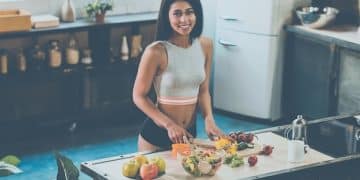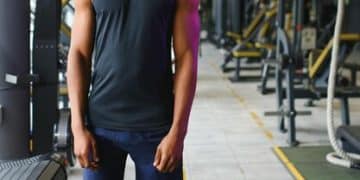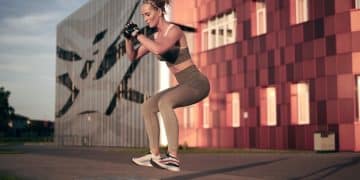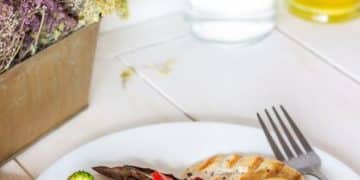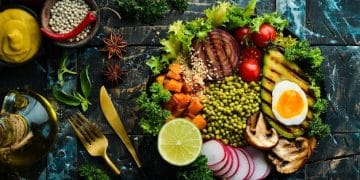No-Cook Bodybuilding Nutrition: Busy Lifestyles 2025
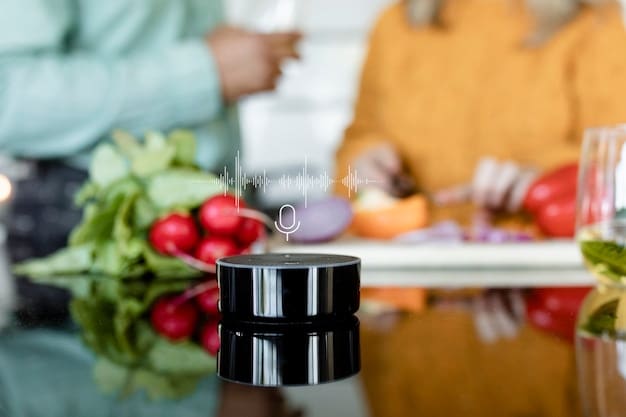
The no-cook bodybuilding nutrition plan for 2025 offers a strategic, time-efficient approach to muscle building and fat loss, emphasizing nutrient-dense, easily prepared foods to support busy lifestyles without compromising dietary goals.
In the relentless pace of modern life, balancing professional demands with personal well-being often seems an insurmountable challenge. For those committed to bodybuilding, this equilibrium becomes even more precarious, with traditional meal prep often consuming hours. This is where The No-Cook Bodybuilding Nutrition Plan: Perfect for Busy Lifestyles in 2025 emerges as a revolutionary solution, offering a streamlined approach to fueling your physique without sacrificing precious time.
The Rise of No-Cook: Why Convenience is King in Bodybuilding Nutrition
The concept of “no-cook” nutrition isn’t new, but its application within the rigorous framework of bodybuilding is gaining unprecedented traction, especially as we look towards 2025. The demands of modern living leave little room for elaborate meal preparation, yet the necessity for precise macronutrient intake remains paramount for muscle growth and recovery. This shift underscores a fundamental re-evaluation of how we approach dietary strategies for peak performance.
Historically, bodybuilding diets were synonymous with endless hours of cooking, portioning, and meticulous tracking. While effective, this traditional model often proved unsustainable for individuals juggling careers, families, and long training sessions. The advent of readily available, high-quality ingredients that require minimal to no preparation has democratized effective nutrition, making it accessible to a broader demographic. This isn’t about cutting corners; it’s about optimizing efficiency without compromising nutritional integrity.
Time-Saving Imperatives for the Modern Athlete
For many, the biggest obstacle to consistent, high-quality nutrition is not a lack of knowledge, but a lack of time. Adopting a no-cook approach significantly reduces the time spent in the kitchen, freeing up hours that can be reallocated to training, recovery, or other life commitments. This efficiency is critical for consistency, which is the bedrock of long-term success in bodybuilding. When nutrition becomes less of a chore, adherence naturally improves.
- Reduced meal prep time, allowing for more training or recovery.
- Elimination of cooking and dishwashing, simplifying daily routines.
- Increased likelihood of consistent healthy eating due to convenience.
- Greater flexibility in meal timing and location.
Beyond the Kitchen: Maximizing Nutritional Value
A common misconception is that no-cook implies a sacrifice in nutritional quality. On the contrary, many no-cook options are inherently nutrient-dense. Think of fresh fruits, vegetables, lean proteins like canned wild salmon or rotisserie chicken, and healthy fats from avocados or nuts. These foods, consumed in their natural state or with minimal processing, often retain more of their vital nutrients compared to heavily cooked alternatives. The focus shifts from complex culinary techniques to intelligent ingredient selection and mindful pairing.
The no-cook paradigm encourages a diet rich in whole foods, prioritizing raw or minimally processed items that are naturally packed with vitamins, minerals, fiber, and phytonutrients. This approach can also lead to a more varied diet, as the simplicity of preparation encourages experimentation with different ingredients that might otherwise seem too time-consuming to incorporate. It’s about smart choices, not complex cooking.
In essence, the no-cook bodybuilding nutrition plan for 2025 represents an evolution in dietary strategy, recognizing that sustainability and convenience are just as vital as macronutrient ratios and caloric targets. It’s a pragmatic solution for a time-constrained world, ensuring that dedication to physique goals doesn’t come at the expense of a balanced life.
Core Principles of No-Cook Bodybuilding Nutrition
Embarking on a no-cook bodybuilding nutrition plan requires understanding core principles that ensure sufficient nutrient intake for muscle synthesis and recovery without the need for heat. This approach prioritizes specific food categories that are both convenient and nutritionally potent, allowing for consistent adherence and optimal results.
The foundation of this plan revolves around highly bioavailable protein sources, complex carbohydrates that provide sustained energy, and healthy fats essential for hormone production and overall well-being. The key is to select ingredients that are either naturally ready-to-eat or require only basic assembly, minimizing preparation time to mere minutes.
Prioritizing Protein: The Building Block Foundation
Protein is non-negotiable for anyone serious about bodybuilding. In a no-cook setting, the focus shifts to protein sources that are either pre-cooked, canned, or naturally ready for consumption. This ensures muscle repair and growth without the need to fire up a stove. The protein should be distributed throughout the day to maximize muscle protein synthesis.
- Canned wild salmon or tuna (packed in water or olive oil).
- Cooked rotisserie chicken (skin removed, shredded).
- Hard-boiled eggs (pre-cooked and peeled).
- Cottage cheese or Greek yogurt (high in casein/whey protein).
- Protein powders (whey, casein, plant-based) mixed with water or milk.
These options provide a diverse array of amino acid profiles, catering to different dietary preferences and ensuring a steady supply of protein. Portioning these items is straightforward, making calorie and macro tracking much simpler.
Complex Carbohydrates and Healthy Fats: Fueling Performance
Carbohydrates are essential for energy, enabling high-intensity workouts and aiding glycogen replenishment. No-cook carbohydrate sources should be low-glycemic, providing slow-release energy to avoid blood sugar spikes and crashes. Healthy fats, on the other hand, are crucial for hormone regulation, nutrient absorption, and satiety. They play a vital role in recovery and overall physiological function.
For carbohydrates, think beyond cooked grains. Options include whole-grain breads, certain fruits, and readily available vegetable sources. For fats, the emphasis is on unsaturated sources that can be easily added to meals or consumed as snacks.

- Oats (overnight oats with milk/water).
- Whole-grain bread or rice cakes.
- Fruits like bananas, apples, berries.
- Pre-cooked quinoa or brown rice pouches.
- Avocados (sliced or mashed).
- Nuts and seeds (almonds, walnuts, chia seeds).
- Nut butters (almond, peanut).
Combining these elements ensures a well-rounded diet that supports intensive training while minimizing time commitment. The art of no-cook bodybuilding nutrition lies in the intelligent selection and combination of these core elements, making it a sustainable and effective strategy for 2025.
Essential No-Cook Pantry Staples for Bodybuilders
Building a successful no-cook bodybuilding nutrition plan hinges on stocking your pantry and refrigerator with the right staples. These are the versatile ingredients that can be mixed and matched to create countless meals without ever turning on the stove. The key is to choose items that are shelf-stable or require minimal refrigeration, while still delivering optimum nutritional value.
A well-stocked no-cook pantry reduces decision fatigue and ensures that healthy options are always within reach, preventing reliance on less optimal convenience foods. It’s about proactive planning and smart shopping.
Proteins: Your Go-To Sources
Having a variety of ready-to-eat protein sources is paramount. These form the backbone of your meals, providing the necessary amino acids for muscle repair and growth. Consider both animal-based and plant-based options to diversify your intake and cater to different preferences.
- Canned Fish: Tuna, salmon, sardines (convenient, high in omega-3s).
- Poultry: Pre-cooked chicken breast strips, rotisserie chicken (shredded).
- Dairy/Dairy Alternatives: Greek yogurt, cottage cheese, hard cheeses, unsweetened almond/soy milk.
- Eggs: Hard-boiled eggs (can be pre-boiled for convenience).
- Legumes: Canned chickpeas, black beans, lentils (rinse thoroughly).
- Protein Powders: Whey, casein, pea protein (for shakes and mixed into other foods).
These selections offer a broad spectrum of textures and flavors, preventing monotony and ensuring adherence to the diet plan.
Carbohydrates: Energy for Performance
Carbohydrates fuel your workouts and aid recovery. No-cook carbohydrate sources focus on complex options that offer sustained energy release without the need for cooking. Think about options that can be eaten directly or require only simple rehydration.
- Grains: Rolled oats (for overnight oats), whole-grain bread, rice cakes, pre-cooked quinoa/brown rice pouches.
- Fruits: Berries, bananas, apples, oranges (fresh or frozen).
- Vegetables: Pre-cut veggies (carrots, celery, bell peppers), spinach, mixed greens, cherry tomatoes.
Incorporating a wide array of fruits and vegetables also boosts your intake of vitamins, minerals, and antioxidants, vital for overall health and recovery.
Fats and Flavor Enhancers: Essential for Health and Enjoyment
Healthy fats are crucial for hormone synthesis, nutrient absorption, and satiety. Flavor enhancers, meanwhile, ensure your no-cook meals are not only nutritious but also enjoyable, which is key for long-term adherence. These items typically require no preparation at all.
- Healthy Fats: Avocados, nuts (almonds, walnuts, cashews), seeds (chia, flax, pumpkin), nut butters.
- Oils: Olive oil, avocado oil (for salad dressings or drizzling).
- Flavor Boosters: Herbs, spices, lemon juice, vinegar, mustard, zero-calorie dressings.
A well-curated no-cook pantry is the secret weapon for any bodybuilder striving for consistent nutrition amidst a busy lifestyle. It simplifies meal creation, making healthy eating effortless and enjoyable.
Sample No-Cook Daily Meal Plan for Bodybuilders (2025 Edition)
Creating a structured, yet flexible, no-cook meal plan is crucial for bodybuilders with demanding schedules. This sample plan provides a blueprint for a full day of eating, ensuring adequate macronutrient intake for muscle growth and recovery, all without cooking. The selections emphasize efficiency, nutrient density, and taste.
Remember that exact portion sizes will vary based on individual caloric and macronutrient needs, specific goals (bulking or cutting), and activity levels. This plan serves as a versatile template that can be adjusted to fit your unique requirements.
Morning Fuel: Breakfast and Mid-Morning Snack
The start of your day dictates your energy levels and metabolic rhythm. No-cook breakfasts prioritize easy-to-digest proteins and complex carbohydrates for sustained energy, while mid-morning snacks prevent hunger and maintain anabolic state.
- Breakfast: Overnight Protein Oats
- ¾ cup rolled oats
- 1 scoop whey or plant-based protein powder
- 1 cup unsweetened almond milk
- ¼ cup mixed berries (fresh or frozen)
- 1 tbsp chia seeds
- (Mix ingredients in a jar/container night before; refrigerate)
- Mid-Morning Snack: Greek Yogurt with Nuts
- 1 cup plain Greek yogurt
- ¼ cup almonds or walnuts
- Optional: Dash of cinnamon or sugar-free syrup
These options are not only quick but highly customizable. You can vary the fruits, nuts, and protein powder flavors to keep things interesting throughout the week.
Midday and Afternoon Sustenance: Lunch and Pre-Workout
Lunches need to be substantial enough to carry you through the afternoon, while pre-workout snacks are strategically timed to fuel your training session. They should be balanced, providing sustained energy without causing sluggishness.
- Lunch: Tuna Salad Lettuce Wraps with Avocado
- 1 can wild tuna (drained, mixed with light mayo or plain Greek yogurt, mustard, celery)
- Large lettuce leaves (e.g., romaine or butter lettuce) for wraps
- ½ avocado, sliced
- Cherry tomatoes on the side
- Pre-Workout Snack (30-60 mins before training): Banana with Nut Butter
- 1 medium banana
- 2 tbsp almond or peanut butter
The tuna lettuce wraps offer protein and healthy fats, while the banana and nut butter provide quick and sustained energy for your workout. Alternatives like pre-cooked rotisserie chicken can be swapped for tuna.
Post-Workout and Evening Recovery: Dinner and Evening Snack
Post-workout nutrition is critical for recovery and muscle repair. Evening meals and snacks focus on delivering ample protein and slow-digesting carbohydrates to support overnight recovery and minimize catabolism.
- Post-Workout/Dinner: Chicken and Veggie Bowl
- 1 ½ cups pre-cooked shredded rotisserie chicken
- 2 cups mixed greens (spinach, kale)
- 1 cup pre-cooked quinoa (from a pouch or leftover)
- ½ cup chopped bell peppers, cucumbers, and carrots (pre-cut)
- Drizzle with olive oil and balsamic vinegar dressing
- Evening Snack: Cottage Cheese with Berries
- 1 cup low-fat cottage cheese
- ¾ cup mixed berries
- Optional: sprinkle of cinnamon or stevia
This full day of no-cook meals demonstrates the feasibility and effectiveness of this approach. It’s designed to be adaptable, ensuring you meet your bodybuilding nutrition targets even on the busiest of days in 2025.
Addressing Common Challenges in No-Cook Nutrition
While the no-cook bodybuilding nutrition plan offers unparalleled convenience, it’s not without its specific set of challenges. Addressing these proactively ensures a more sustainable and effective protocol. Common hurdles include maintaining meal variety, ensuring adequate micronutrient intake, managing perceived blandness, and effectively tracking macronutrients without the precision of cooked ingredients.
Understanding these challenges allows for strategic planning and smart food choices, turning potential obstacles into opportunities for innovation within your dietary framework. The goal is to make the no-cook journey as seamless and enjoyable as possible, optimizing it for 2025 and beyond.
Maintaining Variety and Preventing Flavor Fatigue
One of the biggest concerns for long-term adherence to any diet is monotony. With no-cook meals, the risk of flavor fatigue can be higher if not managed correctly. The key is to leverage different spices, herbs, and condiments that don’t require cooking.
- Rotate Protein Sources: Don’t stick to just tuna. Alternate with canned salmon, shredded chicken, cottage cheese, and various protein powders.
- Experiment with Toppings and Mix-ins: Add different nuts, seeds, dried fruits, fresh herbs (cilantro, parsley), and a variety of colorful vegetables to change textures and flavors.
- Utilize Diverse Condiments: Explore sugar-free dressings, various types of vinegar, mustards, hot sauces, and lemon/lime juice to create different flavor profiles.
Diversifying your ingredient selection and liberal use of healthy flavor enhancers can keep your palate entertained and prevent the diet from feeling restrictive. Think of salads, wraps, and bowls as canvases for various ingredient combinations.
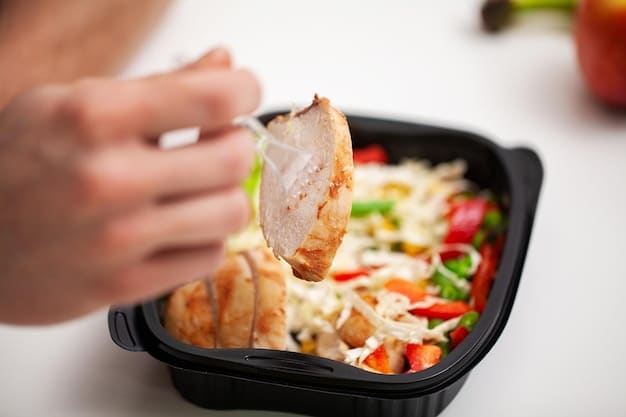
Ensuring Micronutrient Sufficiency and Supplementation
While whole, unprocessed no-cook foods are generally packed with nutrients, relying heavily on a limited set of items could lead to micronutrient gaps. Due diligence is required to ensure you’re getting a full spectrum of vitamins, minerals, and antioxidants essential for performance and overall health.
A diet rich in diverse fruits, vegetables, and whole grains is foundational. However, given the intensity of bodybuilding, strategic supplementation might be beneficial to cover any potential deficiencies that arise from a less varied diet or increased physiological demand.
- Diversify Fruits and Vegetables: Eat a “rainbow” of produce daily to ensure a wide array of vitamins and minerals.
- Include Fortified Foods: Opt for fortified milks or plant-based beverages to boost vitamin D and calcium intake.
- Consider Supplements: A high-quality multivitamin, omega-3 fatty acids, and vitamin D are common considerations for bodybuilders, especially when diet variety is limited. Specific needs might also include B-complex vitamins or magnesium.
Regularly assessing your dietary intake and consulting with a healthcare professional or registered dietitian can help identify any specific micronutrient needs and guide appropriate supplementation. The no-cook plan aims for convenience, but never at the expense of comprehensive nutrition.
Advanced Strategies for No-Cook Meal Prep & Storage
Optimizing your no-cook bodybuilding nutrition plan involves more than just selecting the right ingredients; it requires smart strategies for meal preparation and storage. Effective meal prep in a no-cook context is about assembling meals efficiently and ensuring freshness, while proper storage guarantees safety and extends shelf life. These advanced techniques are essential for busy individuals looking to maximize convenience and consistency in 2025.
The goal is to minimize daily effort by dedicating a limited amount of time to batch preparation of components, which can then be quickly assembled into meals throughout the week. This approach reduces the mental load of daily meal planning and execution.
Batch Prep: Pre-Washing, Chopping, and Portioning
While the “no-cook” moniker suggests zero heat, it doesn’t mean zero preparation. Batching certain foundational ingredients can save immense time during the week. This includes washing, chopping, and portioning items that can be stored and then quickly incorporated into meals.
- Produce Prep: Wash and chop large quantities of resilient vegetables like bell peppers, cucumbers, and carrots. Store them in airtight containers. Wash berries and greens for quick access.
- Protein Pre-Assembly: If using rotisserie chicken, shred the entire bird at once and portion into individual servings. Hard-boil a dozen eggs at the beginning of the week.
- Grain Portioning: If using pre-cooked grain pouches, unseal and portion them into individual containers for easy grabbing.
This preliminary preparation, often done once a week, significantly streamlines daily meal assembly. It transforms raw ingredients into ready-to-use components, minimizing on-the-spot decision-making and effort.
Smart Storage Solutions for Maximum Freshness
Proper storage is critical to maintain food safety, freshness, and palatability. Investing in high-quality containers and understanding storage best practices will prevent spoilage and ensure your no-cook meals remain appetizing throughout the week.
- Airtight Containers: Use glass or BPA-free plastic containers with tight-fitting lids to prevent air exposure, which extends freshness.
- Layering for Salads: When assembling salads, layer ingredients to keep them fresh. Put dressing at the bottom, then hardier vegetables (carrots, cucumber), followed by protein, and finally greens on top. Mix just before eating.
- Separate Components: For meals with varied textures, consider storing components separately (e.g., wet ingredients from dry) to prevent sogginess until mealtime.
By implementing these advanced meal prep and storage strategies, bodybuilders can fully leverage the benefits of a no-cook nutrition plan. It transforms the concept from a simple time-saver into a highly organized and sustainable system for achieving consistent dietary adherence and bodybuilding success.
The Future of Bodybuilding Nutrition: Beyond 2025 with No-Cook
As we advance beyond 2025, the principles underpinning the no-cook bodybuilding nutrition plan are set to become even more ingrained in the fitness landscape. The ongoing innovations in food science, convenience packaging, and personalized nutrition will further enhance the feasibility and effectiveness of this approach. The future of bodybuilding nutrition is trending towards greater customization, ease of access, and sustainability, all of which are perfectly aligned with the no-cook philosophy.
The increasing emphasis on holistic well-being, coupled with the persistent time constraints of modern life, means that simple, efficient, and effective nutritional strategies will continue to gain prominence. The no-cook plan is not merely a trend; it’s a reflection of evolving lifestyles and an intelligent response to contemporary challenges.
Technological Advancements and Food Innovation
The food industry is continuously developing new methods for preserving food, enhancing nutritional profiles, and creating ready-to-eat options that meet rigorous dietary standards. Expect to see more:
- Advanced Packaging: Innovations in packaging design that extend shelf life naturally, maintain freshness, and simplify portion control.
- Plant-Based Proteins: A wider array of highly bioavailable, delicious no-cook plant-based protein options, catering to growing dietary preferences.
- Personalized Meal Services: Growth in services that deliver pre-portioned, no-cook components tailored to individual macronutrient and caloric needs, using AI and data analysis.
These advancements will further democratize elite nutrition, making high-quality, precise dieting accessible to virtually anyone, regardless of their culinary skills or available time. The focus will be on food as fuel, delivered with optimal convenience.
Sustainability and Convenience Converge
Beyond personal convenience, there’s a growing awareness of the environmental impact of food production and consumption. The no-cook approach, by minimizing cooking energy and often favoring less processed foods, can align with more sustainable practices. As supply chains become more efficient and consumers demand eco-friendlier options, the no-cook model will naturally adapt.
Furthermore, the mental and physical burden of daily cooking is significant. By alleviating this pressure, the no-cook plan promotes greater adherence and reduces burnout, factors that are crucial for long-term health and fitness success. This convergence of personal convenience and broader sustainability makes the no-cook paradigm an increasingly attractive and relevant solution.
In essence, the no-cook bodybuilding nutrition plan isn’t a temporary hack but a foundational shift in how we approach fueling our bodies for peak performance. It’s a strategy designed for the modern world, perfectly suited for the busy lifestyles of 2025 and poised to shape the future of dietary adherence for bodybuilders and active individuals worldwide.
| Key Aspect | Brief Description |
|---|---|
| ⏱️ Time Efficiency | Minimizes meal prep, freeing up time for training and personal life. |
| 💪 Nutrient Density | Focuses on whole, minimally processed foods high in essential macros and micros. |
| 🛒 Pantry Staples | Relies on readily available, shelf-stable, and fresh no-cook ingredients. |
| 🔄 Sustainability | Promotes long-term adherence by reducing burnout and simplifying dieting. |
Frequently Asked Questions About No-Cook Bodybuilding Nutrition
▼
Yes, absolutely. Muscle growth depends on a consistent surplus of calories and sufficient protein, not on the method of food preparation. The no-cook plan provides all necessary macronutrients and micronutrients through raw, pre-cooked, or minimally processed foods, allowing for effective muscle building and recovery when combined with proper training.
▼
The no-cook plan is highly effective for a cutting phase. It simplifies measuring and portioning, making calorie and macronutrient tracking easier. By focusing on lean proteins and nutrient-dense, low-calorie vegetables and fruits, you can create a caloric deficit necessary for fat loss while preserving muscle mass, all with minimal preparation.
▼
Food safety is paramount. Ensure you use fresh ingredients, store them properly in airtight containers, and adhere to recommended refrigeration times for perishable items like pre-cooked meats, dairy, and cut fruits/vegetables. Always check expiration dates and practice good hygiene when handling food. Rely on reputable sources for pre-cooked items.
▼
Variety is key to long-term adherence. Rotate your protein sources (tuna, chicken, eggs, cottage cheese), experiment with diverse fruits and vegetables, and use different spices, herbs, and healthy condiments to change flavors. Don’t be afraid to mix and match ingredients or try new no-cook recipes to keep your meals exciting and prevent flavor fatigue.
▼
While the no-cook plan emphasizes whole foods, supplements can help fill potential nutritional gaps common in any intensive bodybuilding diet. Consider a high-quality multivitamin, Omega-3 fatty acids for inflammation and recovery, and perhaps specific minerals like Vitamin D or Magnesium. Protein powder is also a convenient way to boost daily protein intake easily.
Conclusion
The **No-Cook Bodybuilding Nutrition Plan: Perfect for Busy Lifestyles in 2025** is more than just a convenient dietary approach; it is a strategic evolution in how dedicated individuals can achieve their physique goals without compromising the demands of modern life. By emphasizing smart ingredient selection, efficient preparation, and robust nutrient profiles, this plan offers a sustainable pathway to muscle growth, fat loss, and consistent adherence. It stands as a testament to the fact that optimal nutrition doesn’t require hours in the kitchen, but rather intelligent choices and a commitment to efficiency. As we look ahead, the no-cook approach will undoubtedly continue to empower bodybuilders to thrive, proving that convenience and performance can, and should, coexist.
